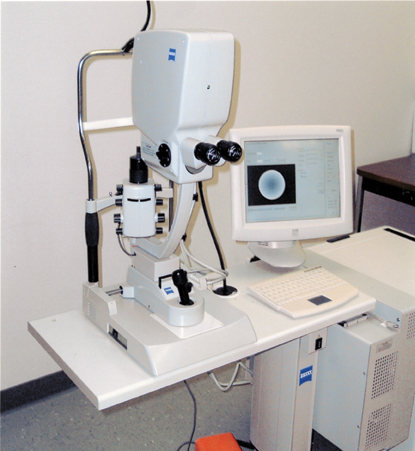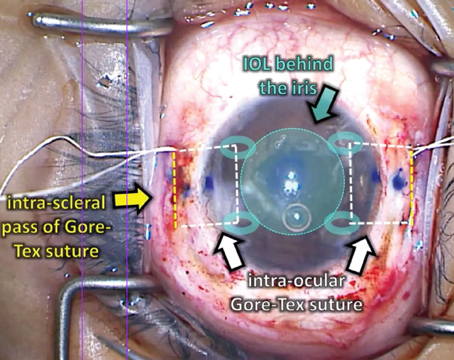The second time's a charm for the Light-adjustable Lens from Calhoun Vision (Pasadena, Calif.). Though the LAL had something of a false start when first implanted in human eyes several months ago, the company appears to have addressed the problems that occurred then, and a surgeon has now implanted the lens successfully in eight patients. If it proves to be effective, it could be a boon to post-refractive patients who happen to need cataract surgery, due to its ability to be customized. Here's an update on this innovative device.
The Adjustment Mechanism
Though the LAL appears conventional to the naked eye, its molecular structure is only partially polymerized. The lens is actually a silicone matrix full of unpolymerized macromers connected to photosensitive molecules.
This partial polymerization allows the lens's power to be adjusted with 365-nm wavelength light, which polymerizes the unpolymerized macromers in a certain configuration based on the patient's refractive error. To generate a specific change in power, the light passes through a special filter that shapes it into the right spatial intensity distribution. Wherever the light strikes the lens it causes the silicone in that area to build up, increasing the thickness there. For example, one distribution pattern might put more light in the periphery of the lens to cause a relative flattening of the center, which could correct a patient's myopia.
Though the treatment itself is quick, about a minute per diopter, it takes several hours before the change in power occurs. The power can be adjusted in 0.25-D increments. Once the patient's vision is as good as can be, the theory behind the lens is that the surgeon can then irradiate the entire lens at once, effectively locking in the power adjustments.
The Lens in Humans
Though the lens's concept had been proven in animals, in February of last year, the first human eyes threw the researchers a curveball.
 |
| The digital light delivery device from Carl Zeiss Meditec will allow more complex patterns to be imprinted onto the light-adjustable lens. |
"We felt pretty confident going to patients because we had such compelling rabbit and preclinical data," says Daniel Schwartz, MD, Calhoun's founder. "We knew it was safe and we had done very precise adjustments in animals, but it turned out that the human cornea behaved quite differently than we had anticipated in terms of transmission of light at this wavelength." The adjustments didn't work.
The setback required Calhoun researchers to go back and perform in vitro experiments with human corneas to find out why the human cornea was so different with respect to this particular wavelength of light compared to what they had anticipated based on the scientific literature. It turns out the humans' corneas both absorbed and scattered the 365-nm wavelength differently than the rabbits' did.
"When we found out why this happened, we were able to see the changes that the human cornea evoked in our light patterns," explains Dr. Schwartz. "With that information, we were able to change those patterns." The result of the extra work was a success in eight cataract patients who had LALs implanted by Arturo Chayet, MD, in Tijuana, Mexico.
In the study, Dr. Chayet implanted lenses in the patients to leave three of them myopic and five hyperopic by a range of 1-2 D, an error he could then adjust postop. The average error was around -1.25 D for the myopes and +1.25 D for the hyperopes.
Since the lens has a 6-mm optic, Dr. Chayet says the company recommends a 5.5-6 mm capsulorhexis. "The ideal size is 5.5 mm," he says. "If it's smaller, it's still all right; the light [for the adjustment] goes through the capsule and can still work to make the adjustment." He performed the adjustment irradiation step with the light emission device, called the Cittrus II, about a week after the implantation, as soon as he was sure there was a stable refraction, a clear cornea and clear ocular media. After the light adjustment step, all eyes are now within 0.25 D of emmetropia.
"First, the good news is that we were able to do the adjustment," says Dr. Chayet. "Second, it's that we were able to be accurate. But, it's also interesting that we didn't modify the astigmatism by even a tenth of a diopter. If a patient was -1.25 -0.75 x 0, the result was plano -0.75 x 0."
The company is hesitant to give the go-ahead for the final lock-in step, however, because everyone involved wants to make sure the lock-in nomogram is accurate in humans.
"They're working on the nomogram," says Dr. Chayet. "When you perform the lock-in, you can possibly make some changes in the lens power because locking in the power involves emitting more light onto the lens, just in a different way. They want to make sure the lock-in doesn't change the refraction."
But will the rabbit data translate to an accurate lock-in for a human eye?
"Yes," says Dr. Chayet. "Because the company will be able to extrapolate the data from the experience of the human-v.-rabbit corneas from the first human adjustments and apply that to the lock-in. I am hoping that will be the case."
In the meantime, Dr. Chayet and the company will be monitoring the patients' lenses and acuities to make sure they remain stable; so far they have.
"The patients' eyes are protected with sunglasses," says Dr. Schwartz. "However, it turns out that the lens material isn't as susceptible to sunlight [before lock-in] as we thought it was. So, we're not as concerned about that." There haven't been any complications thus far.
What's Next
In late May, Calhoun Vision formed an alliance with Carl Zeiss Meditec to make a digital light emission device that would replace the analog one that's now used to make the lens adjustments. This move is in anticipation of making wavefront adjustments in the future.
"With analog, all we really have is a filter with a grayscale pattern through which the light travels," explains Dr. Schwartz. "This filter projects the pattern on the lens. Right now, we just have three filters: myopic, hyperopic and one for the lock-in, and we're just finishing development on a fourth for astigmatism. But if you want to start correcting higher-order aberrations with an analog device, you'd need to generate a filter for each patient. With a digital device, however, you can just take a wavefront measurement of the patient, and then take the conjugate pattern and put it on the lens."
Dr. Chayet is most interested in the possibility of toric corrections with the LAL.
"I see cylinder treatments as the most exciting part," he says. "Because, right now, IOLs can't treat cylinder too effectively. I understand that there is the Staar lens and Alcon is bringing out a [toric] lens, but if we can treat cylinder to within 0.25 D, that would be significant." When asked if lens rotation would confound toric treatments, he says he doesn't think it will be an issue because the LAL is usually secured by the capsule and some fibrosis at about a week postop when the toric adjustment would be made.
Dr. Chayet also sees potential for previous refractive surgery patients who eventually need cataract surgery, since their lens powers are difficult to determine. With an IOL that could be adjusted postop, a lot of the preop guesswork might be avoidable.
Dr. Schwartz says the company also has plans to portray itself more as a "company that will customize vision, whether that means multifocality, wavefront correction or reversible powers that would let a patient try a lens to see if he likes it."
A possible goal is to license the use of the adjustable material to any IOL company that would like to incorporate it into their designs, including accommodative-lens makers.
Eventually, there may even be an adjustable lens that's unlockable.
"The formula we have now is definitely going to be locked," says Dr. Schwartz. "But, down the road, we're working on one that would be unlockable. It would be changeable at any time, which would be helpful, say, in cases of pediatric cataracts in which the eye elongates with age."
The Light-adjustable Lens may begin formal U.S. Food and Drug Administration clinical trials as early as next year.
Dr. Chayet has no financial interest in Calhoun Vision or its lens.





